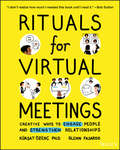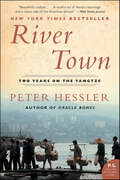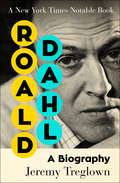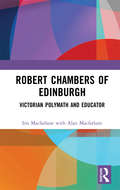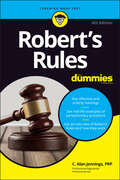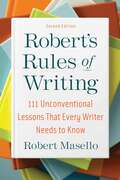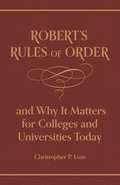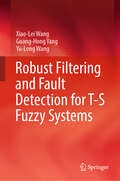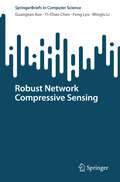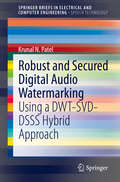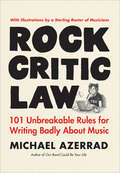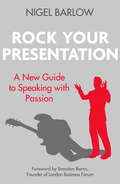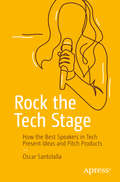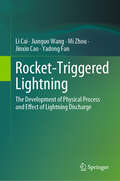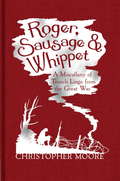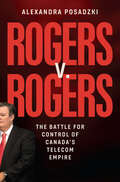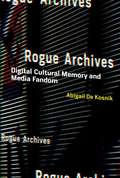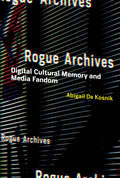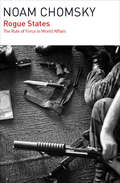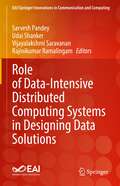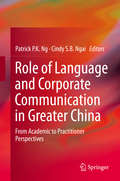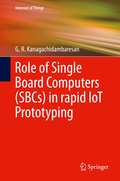- Table View
- List View
Rituals for Virtual Meetings: Creative Ways to Engage People and Strengthen Relationships
by Kursat Ozenc Glenn FajardoDo your virtual meetings feel like a drag? Learn how to use rituals to build trust, increase engagement, and spark creativity. We rely on virtual meetings now more than ever. However, they can often feel awkward, monotonous, and frustrating. If you’re not thrilled with your virtual meetings, rituals can help your group break through to better results by providing structures that unlock freedom. With rituals, virtual meetings can be moments that are elevated and nurtured, opportunities for people to build connection and trust while accomplishing a common goal. In Rituals for Virtual Meetings: Creative Ways to Engage People and Strengthen Relationships authors Kursat Ozenc and Glenn Fajardo show leaders, managers, and meeting organizers how to build rapport and rhythm amongst team members when everyone is not in the same physical space. Rituals for Virtual Meetings provides readers with practical, concrete steps to improve group cohesion and performance, including: How to make virtual meetings more fluid and less awkward How to reduce Zoom fatigue and sustain people’s energy during meetings How to facilitate better interactions with project partners, customers, and clients How community leaders can engage members in a virtual setting How teachers can engage students in virtual classrooms Perfect for anyone who needs to engage people in virtual settings, the book also belongs on the shelves of anyone interested in how to increase team engagement in a variety of contexts.
River Town: Two Years on the Yangtze
by Peter HesslerA New York Times Notable book, this memoir by a journalist who lived in a small city in China is “a vivid and touching tribute to a place and its people” (Kirkus Reviews, starred review). In the heart of China's Sichuan province, amid the terraced hills of the Yangtze River valley, lies the remote town of Fuling. Like many other small cities in this ever-evolving country, Fuling is heading down a new path of change and growth, which came into remarkably sharp focus when Peter Hessler arrived as a Peace Corps volunteer, marking the first time in more than half a century that the city had an American resident. Hessler taught English and American literature at the local college, but it was his students who taught him about the complex processes of understanding that take place when one is immersed in a radically different society.Poignant, thoughtful, funny, and enormously compelling, River Town is an unforgettable portrait of a city that is seeking to understand both what it was and what it someday will be.“This touching memoir of an American dropped into the center of China transcends the boundaries of the travel genre and will appeal to anyone wanting to learn more about the heart and soul of the Chinese people. Highly recommended.” —Library Journal“This is a colorful memoir from a Peace Corps volunteer who came away with more understanding of the Chinese than any foreign traveler has a right to expect.” —Booklist
Roald Dahl: A Biography
by Jeremy TreglownA New York Times Notable Book: A revealing look at the famous twentieth-century children&’s author who brought us The BFG and Charlie and the Chocolate Factory. Few writers have had the enduring cultural influence of Roald Dahl, who inspired generations of loyal readers. Acclaimed biographer Jeremy Treglown cuts no corners in humanizing this longstanding immortal of juvenile fiction. Roald Dahl explores this master of children&’s literature from childhood—focusing a tight lens on the relationship between Dahl and his mother, who lovingly referred to him as &“Apple&”—through to his death. Treglown deftly navigates Dahl&’s time as a fighter pilot in the Royal Air Force, exploring how the experience transformed many of the beliefs that influenced the English writer&’s work, including The Gremlins, which was commissioned by Walt Disney. A former editor of the Times Literary Supplement, Treglown discusses many of Dahl&’s most famous works, such as James and the Giant Peach and Fantastic Mr. Fox, while also delving into his marriage to actress Patricia Neal, combing through letters and archives to show a man who could be both comic and vitriolic, thoughtful yet manipulative and irascible. Treglown highlights many of Dahl&’s literary achievements as well as his breakdowns and shortcomings, presenting a very personal and telling picture of the author and the inner turmoil that crippled him. Separating the man from the myth, Treglown&’s frank, intimate portrait of Dahl illuminates the contradictions within the mind of this beloved author, a man who could be both a monster and a hero. It is required reading for book lovers and film buffs alike.
Robert Chambers of Edinburgh: Victorian Polymath and Educator
by Iris MacfarlaneThis is a book on the life and times of Robert Chambers, founder of W. & R. Chambers publishers. Although there are now books based on some of his letters and on the impact of one of his books, The Vestiges of Natural Creation, there are no books on the whole man and his life. Written by Iris Macfarlane with Alan Macfarlane, the book weaves together three strands. At one level, it is a biography of Chambers and his family; the portrait of a rise from absolute poverty to great wealth and influence. At the second it provides the context of his life by the way of a portrait of nineteenth century Edinburgh as seen through his eyes. At the third it explores the intellectual and organisational revolutions embodied in his life, the explorations in history, folklore, geology, publishing, education and many other fields which made him one of the most exciting thinkers of his age. It is based on extensive archival research among the Chambers’ archives in Edinburgh and conversations with his descendants.Please note: This title is co-published with Social Science Press, New Delhi. Taylor & Francis does not sell or distribute the Hardback in India, Pakistan, Nepal, Bhutan, Bangladesh and Sri Lanka.
Robert's Rules For Dummies
by C. Alan JenningsAll in favor of improving meeting procedures, say Aye! Trying to keep your in-person and virtual meetings on track and running smoothly? You need Robert's Rules of Order! These rules for conducting meetings have stood the test of time as the gold standard for practical and effective procedure in group settings like corporate and nonprofit boards, councils, and more. And there's no better way to learn the latest version of the rules than with Robert's Rules For Dummies. This handy guide demystifies the Rules and offers readers a practical roadmap to applying efficient procedures to everything from conducting online and in-person meetings to voting by email. It also: Contains brand-new, updated content on the latest 12th Edition of Robert’s Rules Offers sample meeting agendas, minutes, scripts, and other material to show you how the pros keep meeting records Walks you through the basic—and not so basic—ways to nominate and elect officers and directors in organizations Ideal for board members, convention delegates, business owners, nonprofit executives, and anyone else trying to maintain an orderly flow of business—online or in person—Robert’s Rules For Dummies is a need-to-read resource that will make you wonder how you ever survived without it.
Robert's Rules of Writing, Second Edition: 111 Unconventional Lessons That Every Writer Needs to Know
by Robert MaselloBestselling author Robert Masello guides working and aspiring writers alike with the hard-won advice, tricks of the trade, and indispensable encouragement that only a seasoned professional can provide.Although there&’s no shortage of books on writing and publishing, there&’s none quite like Robert&’s Rules of Writing: 111 Unconventional Lessons Every Writer Needs to Know. Drawing on his many years of experience as an award-winning journalist, TV writer, and the author of over twenty books published by mainstream houses and translated, to date, into nineteen languages, Robert Masello addresses all the issues that confront, and all the problems that beset, writers of all stripes.Whether you&’re working on a novel or a script, a memoir or a blog, an epic poem or a newspaper piece, you&’re going to have to find the best way to express yourself clearly, persuasively, and entertainingly. You&’ll have to find your own personal voice (much harder than it sounds) and use that unique voice to convey your story, your thoughts, and your opinions, to the many readers out there that you&’re eager to reach; with complete candor and welcome irreverence, Robert&’s Rules of Writing offers the inside knowledge that will help you do just that. As provocative as they are amusing, these rules are purposely designed to challenge the old axioms and get you thinking afresh about your work.In well over a hundred short but pithy takes, Masello guides you over hurdles, around obstacles, and through the seemingly insurmountable barriers to completion and ultimately publication—hooray!—of your writing. It&’s a lively, thought-provoking, and often downright funny addition to any veteran, or fledgling, writer&’s shelf.
Robertson Davies: Magician of Words
by Nicholas MaesBorn in Thamesville, Ontario, a student at Queen’s University in Kingston in the 1930’s, and editor and later publisher of the Peterborough Examiner from the 1940s to the mid-1960s, playwright, essayist, critic, professor, and novelist Robertson Davies (1913-1995) was one of Canada’s pre-eminent literary voices for more than a half-century. Davies, with his generous beard and donnish manner, was the very epitome of the "man of letters," a term he abhorred. Best known for his Deptford Trilogy of novels (Fifth Business, The Manticore, World of Wonders), he also wrote two other trilogies (Salterton and Cornish) and was at work on the third volume of another trilogy (Toronto) when he died. With a life as rich in character and colour as that found in his fiction and essays, Davies had a great fondness for magic and myth, both of which are found in abundance in his work, along with a prodigious streak of wry humour.
Robert’s Rules of Order, and Why It Matters for Colleges and Universities Today
by Christopher P. Loss Henry Martyn RobertA critical edition of the book that paved the way for the democratization of American higher educationIf you have ever attended a town meeting or business lunch, or participated in a church group or department meeting, or served on a faculty senate or maybe just watched C-SPAN, then you have likely encountered Robert's Rules of Order. This critical edition of Henry M. Robert's essential guide to parliamentary procedure features the original text from 1876 along with a companion essay by Christopher Loss, who artfully recounts the book's publication and popular reception, and sheds light on its enduring value for one of the most vital bastions of democracy itself—the modern university.Loss deftly explains why Robert's simple, elegant handbook to democratic governance captured the imagination of so many ordinary citizens during the Gilded Age and how it has shaped the development of our colleges and universities ever since. He shows how Robert's rules can help faculty, administrators, and students to solve problems and overcome challenges through collaboration, disciplined thinking, trust in the facts, and honesty and fairness from all sides.At a time when people's faith in democracy and higher education has been shaken to its core, Robert's Rules of Order offers a powerful reminder of the importance of democratic norms and practices in American life and institutions.
Robust Filtering and Fault Detection for T-S Fuzzy Systems
by Xiao-Lei Wang Guang-Hong Yang Yu-Long WangThis book conducts an in-depth research on robust filtering and fault detection for a class of T-S fuzzy systems. On the basis of the existing research on T-S fuzzy theory, robust filtering theory, and fault diagnosis theory, some new and effective technologies are proposed to solve the problems of robust filtering and fault detection for a class T-S fuzzy systems, while overcoming the shortcomings and limitations of the existing solutions. This book introduces new design solutions for a class of T-S fuzzy systems to address the existing problems in the research of robust filtering and fault detection, namely 1) two new filtering methods are explored to obtain better filtering results than the existing approaches; 2) a new event-triggered filtering scheme is proposed for T-S fuzzy systems with bounded disturbances, which realizes that the designed observer gains in the absence of event-triggered mechanisms are also applicable to the case with event-triggered mechanisms; 3) two new methods are constructed to deal with the asynchronous problems of premise variables effectively, which overcome the defects and limitations of the existing ones; and 4) an effective fault detection scheme for handling measurement outliers is constructed, which can avoid the occurrence of false alarms. This book is intended to inspire researchers and engineers, offering deeper insights into robust filtering and fault detection for T-S fuzzy systems, and equipping them with the latest advancements in fuzzy system theory, robust filtering, and fault diagnosis. It also provides valuable theoretical references for engineers tackling practical engineering problems.
Robust Network Compressive Sensing (SpringerBriefs in Computer Science)
by Minglu Li Feng Lyu Guangtao Xue Yi-Chao ChenThis book investigates compressive sensing techniques to provide a robust and general framework for network data analytics. The goal is to introduce a compressive sensing framework for missing data interpolation, anomaly detection, data segmentation and activity recognition, and to demonstrate its benefits. Chapter 1 introduces compressive sensing, including its definition, limitation, and how it supports different network analysis applications. Chapter 2 demonstrates the feasibility of compressive sensing in network analytics, the authors we apply it to detect anomalies in the customer care call dataset from a Tier 1 ISP in the United States. A regression-based model is applied to find the relationship between calls and events. The authors illustrate that compressive sensing is effective in identifying important factors and can leverage the low-rank structure and temporal stability to improve the detection accuracy. Chapter 3 discusses that there are several challenges in applying compressive sensing to real-world data. Understanding the reasons behind the challenges is important for designing methods and mitigating their impact. The authors analyze a wide range of real-world traces. The analysis demonstrates that there are different factors that contribute to the violation of the low-rank property in real data. In particular, the authors find that (1) noise, errors, and anomalies, and (2) asynchrony in the time and frequency domains lead to network-induced ambiguity and can easily cause low-rank matrices to become higher-ranked. To address the problem of noise, errors and anomalies in Chap. 4, the authors propose a robust compressive sensing technique. It explicitly accounts for anomalies by decomposing real-world data represented in matrix form into a low-rank matrix, a sparse anomaly matrix, an error term and a small noise matrix. Chapter 5 addresses the problem of lack of synchronization, and the authors propose a data-driven synchronization algorithm. It can eliminate misalignment while taking into account the heterogeneity of real-world data in both time and frequency domains. The data-driven synchronization can be applied to any compressive sensing technique and is general to any real-world data. The authors illustrates that the combination of the two techniques can reduce the ranks of real-world data, improve the effectiveness of compressive sensing and have a wide range of applications. The networks are constantly generating a wealth of rich and diverse information. This information creates exciting opportunities for network analysis and provides insight into the complex interactions between network entities. However, network analysis often faces the problems of (1) under-constrained, where there is too little data due to feasibility and cost issues in collecting data, or (2) over-constrained, where there is too much data, so the analysis becomes unscalable. Compressive sensing is an effective technique to solve both problems. It utilizes the underlying data structure for analysis. Specifically, to solve the under-constrained problem, compressive sensing technologies can be applied to reconstruct the missing elements or predict the future data. Also, to solve the over-constraint problem, compressive sensing technologies can be applied to identify significant elementsTo support compressive sensing in network data analysis, a robust and general framework is needed to support diverse applications. Yet this can be challenging for real-world data where noise, anomalies and lack of synchronization are common. First, the number of unknowns for network analysis can be much larger than the number of measurements. For example, traffic engineering requires knowing the complete traffic matrix between all source and destination pairs, in order to properly configure traffic and avoid congestion. However, measuring the flow between all source and destination pairs is very expensive or even infeasible. Reconstructing data from a small number of measurements is an underconstrained proble
Robust and Secured Digital Audio Watermarking: Using a DWT-SVD-DSSS Hybrid Approach (SpringerBriefs in Speech Technology)
by Krunal N. PatelThis book discusses digital audio watermarking copyright assurance. The author first outlines the topic of watermarking data that can be used for copyright assurance that incorporates text messages, copyright audio, handwritten text, logo and cell phone numbers. The objective of this book is to propose a new algorithm that can embed and extract the watermarking information. The execution of the newly proposed algorithm is surveyed by testing data utilizing a group of various audio file types and against various attacks. The book also presents a new digital watermark algorithm that preserves the copyright property of the audio files. To do this, the author uses two techniques -- DWT and SVD -- with the combination of other techniques (DFT and DSSS) to enhance security and also provide high robustness and imperceptibility against various malicious attacks.
Rock Critic Law: 101 Unbreakable Rules for Writing Badly About Music
by Michael AzerradStraight out of his beloved Twitter feed @RockCriticLaw, acclaimed rock journalist and author of the classic books Come As You Are: The Story of Nirvana and Our Band Could Be Your Life, Michael Azerrad turns his trenchant eye to the art of rock writing itself, hilariously skewering 101 of the genre’s seemingly endless litany of hackneyed phrases and tropes.One of the finest music writers today, Michael Azerrad has catalogued the shortcuts, lazy metaphors and uninspired prose that so many of his beloved colleagues all too regularly rely on to fill column inches. In 2014, he began his wickedly droll Twitter feed @RockCriticLaw to expose and make fun of this word-hash. Now, he consolidates these "Laws" into one witty, comprehensive and fully illustrated volume.Rock Critic Law includes timeless gems such as:If a band pioneered something, you must say they are "seminal." That is the Seminal Law of Rock Criticism.If a recording features densely layered guitars, then you MUST use the phrase "sonic cathedrals."Even when it’s easy to find out with research, by all means ask a band how they got their name.Please feel free to deny an artist’s individuality and say they are "the new [x]."If two guitars play a melodic line in harmony, you MUST say they are "twin lead guitars."All 101 Rock Critic Laws are accompanied by original illustrations from Ed Fotheringham, beloved Seattle scenester and highly regarded artist who has created album covers for everyone from, well, seminal grunge band Mudhoney to iconic jazz label Verve Records, as well as illustrations for TheAtlantic, Vanity Fair, The New Yorker and more, making this book a must-have for music lovers everywhere. A unique appreciation of music writing from one of its own, Rock Critic Law irreverently captures all the passion and furor of fandom.
Rock Your Presentation: A New Guide to Speaking with Passion
by Nigel BarlowThis book will protect your audiences from the following disorders:· Death by PowerPoint· Tedium· Compulsive fidgeting· Losing-the-Will-to-Live SyndromeNearly all of us have to pitch or present our ideas, whether in a formal setting like a theatre, at a company conference, in a classroom or even selling a concept one-to-one to our boss. In Rock your Presentation, Nigel Barlow, a professional keynote speaker and creative coach to many of the world's most famous organisations, gives you inspiring insights and practical techniques to 'rock up' your presentation or speech. Many of these tips come from exploring what makes great music so moving and impactful, and are easy to apply to make your own talks more dynamic and memorable. Try changing your key for different emotional impact; come up with a stronger chorus and an exciting climax; create your speaker's rider; be a protest singer to unleash your passion; and learn when and how to go unplugged to touch your audience. Whether you want to create a whole new presentation or tune up a tired old one, Rock Your Presentation will give you plenty of fresh ideas.
Rock Your Presentation: A New Guide to Speaking with Passion
by Nigel BarlowNearly all of us have to pitch or present our ideas, whether in a formal setting after lunch to a hundred jaded salespeople, in a lecture theatre or classroom, putting over our thoughts to a team of colleagues, or even selling a concept one-on-one to your boss.In all these situations we can choose between delivering a message that sounds like muzak, or one that wakes the listener up. Most presentations and pitches could benefit from being 'rocked up' - becoming more dynamic and memorable, in ways that arouse the passion of the audience. By applying the ideas in ROCK YOUR PRESENTATION you can deliver better, livelier and more emotionally engaging talks which leave audiences with the kind of high you get from being in a crowd at a great concert.Barlow applies the rock'n'roll metaphor throughout the book, turning what, to many, is a stressful subject into an exciting and fun exercise you can't wait to try out. So take the Van Halen approach to planning your presentation, deliver it like a hit song with a chorus and a bridge, play a few well-rehearsed power chords and set your audience ablaze.
Rock the Tech Stage: How the Best Speakers in Tech Present Ideas and Pitch Products
by Oscar SantolallaThis book unveils ten secrets on how to masterfully speak in the technology arena. It is primarily based on stories from entrepreneurs, executives and engineers from technology companies that have shaped history: Steve Jobs, Tim Cook, Elon Musk, Jim Grubb (Cisco), Mikko Hyppönen (F-secure), Jane Chen (Embrace Innovations) and many more. Most of them have appeared on the stages of large conferences and events presenting their products and inventions. Today the technology arena is more dynamic and innovating than ever: mobile applications, cloud services, artificial intelligence, clean technologies, blockchain, etc.There are increasingly more spaces to share knowledge and promote products. Both aspects make speaking about technology harder than ever: how should you speak about your product or company in a way that your audience not only gets what you say but gets inspired enough to become followers?The ten practices presented in this book are: story, demo, metaphor, data visualization, passion, props, presentation hacks, interaction, staging, and memory. All core aspects that a technical person needs to rock the stage at conferences. What You Will LearnA wide range of skills which will help you make a solid and persuasive presentation or talkHow to craft compelling storiesHow to write better (blogs and copy) about technical products and eventsWho This Book is ForDevOps, developer evangelists, testers, architects, product managers, sales engineers, solution architects, CTOs, CEOs, startup founders, marketers
Rocket-Triggered Lightning: The Development of Physical Process and Effect of Lightning Discharge
by Mi Zhou Jianguo Wang Li Cai Jinxin Cao Yadong FanThis book summarises the fruitful results of rocket-triggered lightning experiments conducted in Guangdong, China, in recent years, including data analysis and theoretical research. One of the main features of this book is to compare the differences between lightning strikes on overhead power lines and strikes on the ground. Starting from the technical background and experimental methods of rocket-triggered lightning, the book delves into the electric current, electric field, magnetic field, optical and acoustic characteristics of artificially triggered lightning. Proceeding progressively from basic to advanced levels, this book meets the needs of scientists at different levels of expertise. It will benefit researchers, engineers and graduate students working in the fields of lightning detection, lightning physics and lightning protection.
Roger, Sausage and Whippet: A Miscellany of Trench Lingo from the Great War
by Christopher MooreRoger: A code word for a gas cylinder and a nickname for rum. Sausage: An observation balloon. Whippet: A small, light type of tank with a top sped of eight m.p.h. The First World War raged for four years, taking with it hundreds of thousands of young soldiers who lived and died together, bonded by the horror of the war. Now, all the way from the trenches and through the letters of Christopher Moore's Captain Cartwright, comes an extraordinary lexicon of the phrases and lingo of life at the front. Whether born from the desperation of gallows humour ('If it keeps on like this, someone's going to get hurt'), borrowed from Cockney rhyming slang, Latin, French and other languages ('Cushy: Comfortable, safe, pleasant. From the Hindustani: khush, pleasure') or even taken from the name of the Huntley and Palmer biscuit company, Tommy had a new word for almost everything. From Ammo to Zig-Zag, this is a fascinating glimpse into the world of our First World War heroes. So fetch the dooly and the other makings, brew up some char, and read on safe in the knowledge that you won't be going over the top today...
Rogers v. Rogers: The Battle for Control of Canada's Telecom Empire
by Alexandra PosadzkiA riveting, deeply reported account that takes us inside the dramatic battle for control of Canada&’s largest wireless carrier, and paints a broader picture of the cutthroat telecom industry, the labyrinth of regulatory and political systems that govern it, and the high-stakes corporate games played by the Canadian establishment. Alexandra Posadzki&’s ground-breaking coverage in the Globe and Mail exposed one of the most spectacular boardroom and family dramas in Canadian corporate history—one that has pitted the company&’s extraordinarily powerful chairman and controlling shareholder, Edward Rogers, against not only his own management team but also the wishes of his mother and two of his sisters. Hanging in the balance is no less than the pending $20 billion acquisition of Shaw Communications, a historic deal that promises to transform Rogers into the truly national telecom empire that its late founder, Ted Rogers, always envisioned. Based on deeply sourced, investigative reporting of the iconic $30 billion publicly traded telecom and media giant, Posadzki takes us inside a company that touches the lives of millions of Canadians, challenging what we thought we knew about corporate governance and who really holds the power. Rogers v. Rogers is also a story of family legacy and succession, of an old guard pushing back at the new guard, and of a company struggling to find its footing in the wake of its legendary founder&’s death. At the heart of it all is a dispute between warring factions of the family over how they each interpret the desires of the late patriarch and the very identity of the company that bears their name.
Rogue Archives: Digital Cultural Memory and Media Fandom
by Abigail De KosnikThe task of archiving was once entrusted only to museums, libraries, and other institutions that acted as repositories of culture in material form. But with the rise of digital networked media, a multitude of self-designated archivists -- fans, pirates, hackers -- have become practitioners of cultural preservation on the Internet. These nonprofessional archivists have democratized cultural memory, building freely accessible online archives of whatever content they consider suitable for digital preservation. In Rogue Archives, Abigail De Kosnik examines the practice of archiving in the transition from print to digital media, looking in particular at Internet fan fiction archives.De Kosnik explains that media users today regard all of mass culture as an archive, from which they can redeploy content for their own creations. Hence, "remix culture" and fan fiction are core genres of digital cultural production. De Kosnik explores, among other things, the anticanonical archiving styles of Internet preservationists; the volunteer labor of online archiving; how fan archives serve women and queer users as cultural resources; archivists' efforts to attract racially and sexually diverse content; and how digital archives adhere to the logics of performance more than the logics of print. She also considers the similarities and differences among free culture, free software, and fan communities, and uses digital humanities tools to quantify and visualize the size, user base, and rate of growth of several online fan archives.
Rogue Archives: Digital Cultural Memory and Media Fandom
by Abigail De KosnikAn examination of how nonprofessional archivists, especially media fans, practice cultural preservation on the Internet and how “digital cultural memory” differs radically from print-era archiving.The task of archiving was once entrusted only to museums, libraries, and other institutions that acted as repositories of culture in material form. But with the rise of digital networked media, a multitude of self-designated archivists—fans, pirates, hackers—have become practitioners of cultural preservation on the Internet. These nonprofessional archivists have democratized cultural memory, building freely accessible online archives of whatever content they consider suitable for digital preservation. In Rogue Archives, Abigail De Kosnik examines the practice of archiving in the transition from print to digital media, looking in particular at Internet fan fiction archives.De Kosnik explains that media users today regard all of mass culture as an archive, from which they can redeploy content for their own creations. Hence, “remix culture” and fan fiction are core genres of digital cultural production. De Kosnik explores, among other things, the anticanonical archiving styles of Internet preservationists; the volunteer labor of online archiving; how fan archives serve women and queer users as cultural resources; archivists' efforts to attract racially and sexually diverse content; and how digital archives adhere to the logics of performance more than the logics of print. She also considers the similarities and differences among free culture, free software, and fan communities, and uses digital humanities tools to quantify and visualize the size, user base, and rate of growth of several online fan archives.
Rogue States: The Rule of Force in World Affairs (Chomsky Perspectives Ser. #No. 13)
by Noam ChomskyThe bestselling author and activist &“has delivered another impressive argument that the U.S. flouts international law when it finds it convenient to do so&” (Publishers Weekly). In this still-timely classic, Noam Chomsky argues that the real &“rogue&” states are the United States and its allies. Chomsky turns his penetrating gaze toward US involvement in the Middle East, Southeast Asia, the Caribbean, and Latin America to trace the enduring combined effects of military domination and economic imperialism on these regions. &“Noam Chomsky is like a medic attempting to cure a national epidemic of selective amnesia . . . [Rogue States is] a timely guide to the tactics that the powerful employ to keep power concentrated and people compliant . . . Chomsky&’s work is crucial at a time when our empire perpetually disguises its pursuit of power under the banners of &‘aid,&’ &‘humanitarian intervention,&’ and &‘globalization.&’ Americans have to begin deciphering the rhetoric. Chomsky&’s a good place to start.&” —The Village Voice &“World-famous MIT linguist Chomsky has long kept up a second career as a cogent voice of the hard left, excoriating American imperialism, critiquing blinkered journalists and attacking global economic injustice.&” —Publishers Weekly &“Nothing escapes [Chomsky&’s] attention . . . [Rogue States is] wonderfully lucid.&” —PeaceWork Praise for Noam Chomsky &“Chomsky is a global phenomenon . . . perhaps the most widely read voice on foreign policy on the planet.&” —The New York Times Book Review &“The conscience of the American people.&” —New Statesman &“One of the radical heroes of our age . . . a towering intellect . . . powerful, always provocative.&” —The Guardian
Role Mate to Soul Mate: The Seven Secrets to Lifelong Love
by Warren FarrellNew York Times bestselling author Dr. Warren Farrell reveals solutions to the seven most important barriers to sustaining love—practices that have helped thousands of real couples rediscover their "soul mate" spark. When Dr. Farrell began teaching couples&’ communication 30 years ago, he taught the wisdom of not being defensive in response to criticism. However, when a couple returned home and a criticism inevitably appeared, that wisdom disappeared. Couples needed to not just be taught this, but to practice both in the workshop and at home. With the help of decades of post-workshop feedback from real couples, Farrell perfected six mindsets that the couples found most effective to embrace criticism as an opportunity to feel more deeply loved—even while they are being criticized. Role Mate to Soul Mate guides couples on how to do this for two hours per week as a &“Caring and Sharing Practice.&” For the other 166 hours, couples create a &“Conflict-Free Zone&” the other 166 hours, which requires preventing criticisms from becoming conflicts. To do this, you&’ll learn how to: Appreciate your loved one with five levels of specificity, both creatively and consistently Transform the &“Four Depleters of Love&” (Criticisms, Complaining, Complacency, and Controlling) into ways to deepen love Master the eleven &“Soulmate Wisdoms&” Play together, because &“couples that play together stay together&” Create win-win solutions to your stickiest problems Apply your new skills to family, friends, colleagues—and even political opponents Since falling in love is natural but sustaining love is unnatural, making these skills come naturally requires an evolutionary shift that is both an art and a discipline. The Role Mate to Soul Mate reward? A deeper, dynamic, and lifelong love.
Role of Data-Intensive Distributed Computing Systems in Designing Data Solutions (EAI/Springer Innovations in Communication and Computing)
by Vijayalakshmi Saravanan Sarvesh Pandey Udai Shanker Rajinikumar RamalingamThis book discusses the application of data systems and data-driven infrastructure in existing industrial systems in order to optimize workflow, utilize hidden potential, and make existing systems free from vulnerabilities. The book discusses application of data in the health sector, public transportation, the financial institutions, and in battling natural disasters, among others. Topics include real-time applications in the current big data perspective; improving security in IoT devices; data backup techniques for systems; artificial intelligence-based outlier prediction; machine learning in OpenFlow Network; and application of deep learning in blockchain enabled applications. This book is intended for a variety of readers from professional industries, organizations, and students.
Role of Language and Corporate Communication in Greater China
by Patrick P.K. Ng Cindy S.B. NgaiThis book features not only the latest trends but also academic and industry practitioner stakeholders' perspectives on language and functional role issues facing the rapidly developing corporate communication (CC) profession in the Greater China region. The book also explores the implications for Western societies that cross-culturally engage with Chinese partners in CC practices. The book's chapters are oriented on five main themes, namely: Development of the CC Profession, Bilingual Practices in Corporate Communication, Corporate Social Responsibility, Employee Communications, and Media Discourse & Persuasive Communication. The first two cluster themes feature a review of the PR/CC profession's evolutionary path to its current status as a more distinct and diversified CC profession emphasizing the role of language and particularly the bilingualism phenomenon, whereas the other cluster themes, which adopt the perspectives of academics and those of CC practitioners, span from cross-cultural, profession-wide and bilingual communication issues to applications of heuristic knowledge within industry-specific workplace contexts.
Role of Single Board Computers (Internet of Things)
by G. R. KanagachidambaresanThis book presents how to program Single Board Computers (SBCs) for Internet of Things (IoT) rapid prototyping with popular tools such as Raspberry Pi, Arduino, Beagle Bone, and NXP boards. The book provides novel programs to solve new technological real-time problems. The author addresses programming, PCB design and Mechanical Cad design all in single volume, easing learners into incorporating their ideas as prototype. The aim of the book is to provide programming, sensors interfacing, PCB design, and Mechanical Cad design to and create rapid prototyping. The author presents the methodologies of rapid prototyping with KiCAD design and Catia software, used to create ready to mount solutions. The book covers scripting- based and drag/drop- based programming for different problems and data gathering approach.
